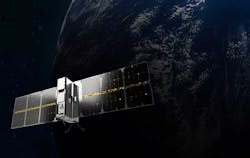BigData From Space: How Satellite Launches Power Cloud Growth
Doug Mohney is the of Editor in Chief of Space IT Bridge, which tracks the business of space-based satellites. He has been working in and writing about IT and satellite industries for over 20 years.
A successful SpaceX rocket launch conducted on June 30 will conservatively add 30 to 40 terabytes of data per day to cloud services around the world. This river of data generated by “New Space” companies will flow into Amazon Web Services and other major cloud providers to be stored, processed and made available to customers within hours.
“This was one of the most important launches for the commercial (earth observation) industry, with satellites containing different types of sensors generating data to be used across various industries – from SAR in insurance for flood monitoring to RF in maritime surveillance for pirate ship tracking,” said Aravind Ravichandran, an Independent Space Consultant & Market Analyst at TerraWatch Space. “More importantly, the infrastructure has been laid, and it’s now time to start making use of the data enabled (by) these satellites to start generating a business case for these NewSpace EO (earth observation) startups to continue sending more satellites up.”
A total of 88 satellites were on board the Transporter-2 rideshare mission, including numerous imaging and IoT spacecraft, with several satellites providing hosted services for companies that don’t want to build and run their own flying hardware – think of them as forerunners to dedicated data centers in the sky.
SpaceX stared its rideshare launch program in 2019, declaring it would launch a dedicated Falcon 9 rocket to sun synchronous orbit (SSO) three times a year. Companies putting satellites into orbit now have access to regularly scheduled “bus trips” into space, paying around $5,000 per kilogram in bulk if dealing directly with the launch provider; a bit more if they go through a rideshare broker aggregating numerous smaller satellites together.
For firms building constellations of satellites to provide global coverage and rapid revisit times to anywhere on the earth, SpaceX’s rideshare program is a great value from a price and convenience perspective. What follows below is an incomplete snapshot of the data generating commercial satellites and doesn’t include university and government research spacecraft placed into orbit.
IoT and In-Space Hosting Options
One approach to lowering the cost of Internet of Things (IoT) service worldwide is to use satellites the size of a wine box or even smaller to collect little amounts of data from low-power devices out of range from existing terrestrial networks. Depending on the design of the satellite IoT network and the sensors being monitored, a data transmission from a device on the ground may only be 160 characters or less with pickup from a satellite flying overhead scheduled for simply once a day. Satellite sizes are express in standard units (“U”) measuring 10 by 10 by 10 centimeters.
Astrocast added five 3U CubeSat-size satellites to their IoT constellation and are currently at 10 satellites total in their operational network. A 3U CubeSat is about the size of a wine box before launch, with antennas and solar panels popping out once it is released from the satellite. Astrocast anticipates another 10 satellites put into orbit by the end of the year for a total of 20 satellites with an ultimate goal of 100 satellites by 2024.
Fleet Space Technologies Centauri 4’s latest satellite is a 6U CubeSat roughly the size of a large shoe box, giving the company a total of five satellites in orbit.
Swarm Technologies had the largest number of small satellites to orbit on the flight as well as the smallest sized satellites. Twenty-eight SpaceBEE satellites, each roughly the size of a piece of Texas Toast, were successfully placed in orbit. The company has over 100 SpaceBEEs in orbit and plans to have 180 in place for its full constellation.
OQ Technology‘s first satellite, Tiger-2, is a 6U CubeSat designed to communicate with devices using 3GPP cellular NB-IoT standards.
Not all IoT companies onboard Transporter-2 chose to build their own dedicated satellites, but were hosted with others on larger satellites, sharing space, power, and radio resources, either with dedicated hardware or virtually through software. In-Space Mission’s Faraday Phoenix 6U CubeSat satellite, the company’s first, will provide services for six customers, including IoT firm Lacuna Space.
Loft Orbital placed two satellite into orbit on Transporter-2, YAM-2 and YAM-3. Eultelsat has its first two ELO IoT payloads onboard the Loft Orbital spacecraft – one per satellite – while Totum Labs flew a 1U-sized hardware payload full of processing power on one of the satellites to start testing its new 2.4 GHz locational tracking tech.
Optical Imaging Data: A Bit Cloudy, but Gigabytes/day
Based in Uruguay and heading for Wall Street via a SPAC, Satellogic put four new imaging satellites into orbit. Each satellite weighed in around 38.5 kilograms with a size of 82 centimeters (cm) by 51 cm by 57 cm and is capable of taking 70 centimeter resolution color still images, 25 meter resolution hyperspectral imaging, and 1 meter resolution full motion video.
A company spokesperson said a single satellite can image over 300,000 square kilometers per day, but would not discuss details on overall data collection size. Competitor Maxar said it collects 80 TB/day with its existing fleet of satellites while Planet collects 25 TB/day, according to Ravichandran, and is expected to go to 40 TB/day once it completes SuperDove satellite fleet upgrade.
Perhaps the company will reveal more information as it promotes its recently announced SPAC. Satellogic will raise $274 million which it plans to use building satellites, planning to have 300 in orbit by 2025.
SAR Brings the Terabytes
The biggest data creators onboard the SpaceX Transporter-2 launch were synthetic aperture radar (SAR) satellites. Able to see through clouds and at night, SAR satellites have significant value to national security organization and as well as being used in a variety of commercial applications. These can range from analyst firms such as Ursa Space tracking the crude oil inventories and oil field equipment yards as an indicator on the future price of oil to transport companies tracking sea ice and icebergs to plot the safest and most efficient shipping routes.
U.S.-based Capella Space and Umbra Labs both launched single satellites on the Transporter-2 mission while Finnish-based ICEYE put four of its smaller Cubesat-sized spacecraft into orbit, three of its current model and one next-generation technology pathfinder.
A single Capella Space SAR satellite can collect anywhere from 2 TB to 5 TB of raw data per day, according to a company official interviewed by Data Center Frontier last year. Generating products from the raw data to analyst-ready imagery can conservatively multiple that by a factor of five; i.e. creating anywhere from 10 TB up to 25 TB per day. Capella Space provides imagery with 50 centimeter resolution.
ICEYE’s trio of first-generation satellites could generate a terabyte or more of data per day, while the next-generation pathfinder is expected to improve ground resolution by a factor of two. The company typically provides imagery between 3 meter and 10 meters but has a spot mode capable of 25 centimeter resolution.
Umbra Labs has declined on several occasions to discuss the amount of data its satellites will generate, citing proprietary concerns, but it’s likely to be at least as large as Capella’s 2-5 TB/satellite/day and potentially more given the company’s radar antenna design and assertions it will deliver industry-leading resolution of 15 centimeters.
While ICEYE and Umbra were reluctant to discuss the amount or growth of their data generation activities, Capella Space was more open. “Since we officially launched our commercial operations at the beginning of 2021, we’ve been doubling the total amount of data generated from our constellation every quarter,” said Payam Banazadeh, CEO and Founder of Capella Space. That rate of growth is likely to continue in the near term, with Capella planning to launch more satellites by the end of the year.
Adding up estimates for Capella Space, ICEYE, and Umbra Labs gives a low-end estimate of over 5 TB/day of raw SAR data to a high of 12 TB/day or more. Post-processing of Capella Space’s SAR data into finished products adds another 10 TB to 25TB per day, for at least 30 TB/day generated by that company alone for a single satellite. ICEYE and Umbra Labs may generate similar multiples of TBs when their raw data is turned into end-user products.
The Constellation Multipler x Time = Petabytes to the Cloud
As noted earlier, the SpaceX Transporter-2 launch is only a single piece in a larger puzzle. Earth observation firms are building constellations of dozens to hundreds of satellites designed to capture the entire Earth’s surface daily and to revisit areas of interest multiples times per day.
Planet, hosted by Google, will collect 40 TB/day once it finishes upgrading its current fleet of over 100 Dove satellites to SuperDoves. Over the course of a month (30 days), that’s 1.2 petabytes of unprocessed data, and a year 14.4 petabytes. With post-processing, AI/ML routines to spot changes over time and find features of interest, simple customer web portal access is noise in the monthly cloud bills.
Amazon, which hosts Capella Space’s operations, has much to look forward to in the months and years ahead. Capella Space intends to operate a constellation of 36 satellites. With a full constellation, Capella will generate anywhere from 72 to 360 TB/day of unprocessed data, easily putting them into the petabyte range every month – before they start processing data.
With business customers that have data needs of this size, it is no surprise Amazon and Microsoft are both providing direct connections and one-stop-shopping for satellite control through their respective cloud services.
About the Author



